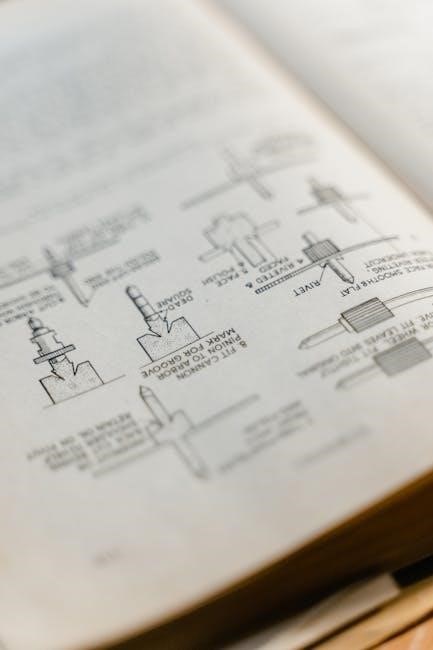The Legend of Zelda NES Instruction Manual is a vital guide for players, detailing the game’s story, mechanics, and items. Digitally preserved as PDFs and fan scans, it remains a cherished collector’s item, bridging nostalgia and modern accessibility.
1.1 Historical Significance of the Manual
The Legend of Zelda NES Instruction Manual holds significant historical value as the first official guide for the iconic 1986 game. Released alongside the NES launch, it introduced players to the expansive world of Hyrule, detailing its lore and gameplay mechanics. As the inaugural guide in the Zelda series, it set the standard for future manuals, influencing how players engaged with the franchise. Its detailed maps and strategies became a blueprint for later games, making it a cherished collector’s item. Digitally preserved today, it remains a testament to the origins of one of gaming’s most beloved franchises, cherished by fans and collectors alike.
1.2 Purpose of the Instruction Manual
The purpose of the Legend of Zelda NES Instruction Manual was to guide players through the game’s unique open-world design, which was revolutionary at the time. It provided essential information about controls, items, and dungeon strategies, helping players navigate the vast overworld and underground labyrinths. The manual also outlined the game’s lore, introducing the Triforce and the battle between good and evil. By offering clear instructions and tips, it ensured players could fully immerse themselves in the adventure without frustration, making it an indispensable companion for both new and experienced gamers.
1.3 Audience and Accessibility
The Legend of Zelda NES Instruction Manual was designed for a broad audience, including both children and adults, making it accessible to all skill levels. Its clear, concise language and visual guides ensured that even younger players could understand the game’s mechanics. The manual’s inclusion of maps and strategies catered to both casual and experienced gamers, while its digitized versions today allow modern players to access the guide easily. This accessibility has helped maintain the manual’s relevance, ensuring it remains a valuable resource for new and veteran players alike.

Contents of the Manual
The manual includes the game’s story, detailed gameplay mechanics, lists of items and equipment, and strategies for navigating dungeons, providing essential information for players.
2.1 The Story of The Legend of Zelda
The manual introduces the land of Hyrule, a kingdom plagued by chaos after Ganon steals the Triforce of Power. Princess Zelda hides the Triforce of Wisdom, and the land awaits a hero. Link, the protagonist, embarks on a quest to gather the eight fragments of the Triforce of Wisdom, defeat Ganon, and rescue Zelda. The story establishes the foundational lore, emphasizing courage, wisdom, and strength as essential virtues for Link’s journey. This narrative sets the stage for the game’s adventures, guiding players through the epic tale of good vs. evil in Hyrule.
2.2 Gameplay Mechanics and Controls
The manual outlines the essential controls and mechanics for navigating Hyrule. Players control Link using the D-pad, with the A button for attacking and B for using items or shields. Start pauses the game, and Select switches between items. The manual explains how to manage inventory, use bombs, and interact with NPCs. It details movement mechanics, such as swimming and climbing stairs, and emphasizes the importance of exploration and item usage. Instructions on battling enemies, solving puzzles, and progressing through dungeons are also provided, ensuring players grasp the game’s core systems and strategies for success. This section is crucial for mastering the adventure.
2.3 Items and Equipment Guide
The manual details a wide array of items and equipment essential for Link’s quest. Key items like the Boomerang, Bombs, and Magical Shield are explained, along with their uses in combat and puzzle-solving. The Wooden Sword and Fire Rod are highlighted as crucial upgrades, while the Stepladder and Raft enable access to new areas. Each item’s function, location, and strategic value are described, helping players understand how to collect and utilize them effectively. This guide ensures players can equip Link properly for the challenges ahead, enhancing their ability to explore and conquer Hyrule.
2.4 Dungeon Maps and Strategies
The manual includes intricate dungeon maps, illustrating the layout of each underground labyrinth. Strategic advice is offered to help players navigate efficiently, emphasizing optimal routes and resource management. Key locations such as entrances, exits, and important item rooms are clearly marked, ensuring players can progress without unnecessary backtracking. Tips on conserving health and effectively using items are also provided, enhancing the player’s ability to overcome challenges and complete each dungeon successfully.

Collector’s Value and Rarity
The Legend of Zelda NES manual is highly sought by collectors, with first prints holding significant value. Authenticity is key, as identified by the Star Code variant, impacting market demand and pricing based on condition.
3.1 First Print vs. Later Editions
The first print of The Legend of Zelda NES manual is highly prized among collectors due to its rarity and historical significance. Identifiable by the “Star Code” variant, these early editions are more valuable in good condition. Later prints introduced minor textual revisions and design tweaks, making them slightly less sought after. Collectors often prioritize first editions for their originality and nostalgic appeal, while later versions remain valuable but more accessible. Both editions are cherished, but the first print holds a special place in the hearts of enthusiasts and historians of the Zelda series.
3.2 Authenticity and Identification Tips
Authenticating a Legend of Zelda NES manual requires attention to detail. Look for the official Nintendo seal and correct page count (36 pages). Early editions feature a “Star Code” variant on the back cover. Check for high-quality paper and vibrant colors, as low-quality scans are common in reproductions. Ensure all text is properly aligned and free of blurry images. Examine the cover art for accuracy, and verify the presence of the game’s story and controls. Avoid manuals with torn or poorly repaired pages, as these may indicate authenticity issues or improper restoration.
3.4 Market Demand and Pricing
The Legend of Zelda NES manual is highly sought after by collectors, driving up demand. Prices vary based on condition and rarity. First-print manuals with the Star Code can sell for over $100, while later editions are more affordable. High-grade, mint-condition copies are rare and fetch premium prices. The market remains active, with enthusiasts and retro gaming fans willing to pay top dollar for authentic, complete manuals. Online marketplaces like eBay often list these manuals, reflecting their enduring popularity and value among collectors of vintage gaming memorabilia.

Digital Versions and Preservation
Digital versions of the manual are available as official PDFs and fan-made scans, ensuring accessibility for modern players while preserving the original content for future generations.
4.1 Official PDF Releases
Nintendo has officially released the Legend of Zelda NES manual as a downloadable PDF, preserving its original content for modern accessibility. Available on the NES Mini website, this digital version includes the complete guide, featuring the game’s story, controls, and item descriptions. The PDF format ensures clarity and ease of access, allowing fans to revisit the manual without physical storage concerns. Additionally, the official release maintains the original artwork and layout, making it a faithful representation of the iconic manual. This digital preservation effort ensures that future generations can appreciate the foundational guide of the beloved classic.
4.2 Fan-Made Scans and Archives
Fan-made scans and archives of the Legend of Zelda NES manual have been widely shared online, offering high-quality digitized versions for enthusiasts. These scans, often created by dedicated collectors, include detailed images of every page, preserving the original layout and artwork. Some archives even feature OCR (Optical Character Recognition) versions, making the text searchable and accessible. Platforms like Gameamp&watch and community forums host these resources, allowing fans to download and refer to the manual without needing a physical copy. These efforts highlight the community’s dedication to preserving gaming history for future generations.
4.3 NES Mini and Virtual Console Availability
The NES Mini and Virtual Console have made the Legend of Zelda manual accessible in digital formats. Nintendo released official PDF versions of the manual for these platforms, ensuring compatibility with modern gaming systems. Players can access the manual directly through the NES Mini’s interface or download it via the Virtual Console. This convenience allows both retro gaming enthusiasts and newcomers to enjoy the game with original guidance, preserving the authentic experience while embracing contemporary technology.

Tips for New Players
Start by mapping the overworld and dungeons to avoid getting lost. Always carry extra bombs and arrows. Explore thoroughly, as hidden items are crucial. Avoid forgetting to buy essential items from shops. Use bombs strategically, and don’t forget to collect heart containers to increase health. Remember to save frequently, and consult the manual for timeless strategies to enhance your adventure and success in the game.
5.1 Essential Information for Beginners
Welcome to Hyrule! As a new player, understanding the basics is key. The manual outlines the game’s objective: rescue Princess Zelda by exploring dungeons and collecting the Triforce of Wisdom. Learn the controls, as precise movement is crucial. Start by exploring the overworld, using your sword to defeat enemies and collect hearts for health. Manage your items wisely, as bombs and arrows are limited. Maps and strategies in the manual help navigate the vast world. Don’t overlook hidden secrets, like heart containers and optional items. The manual also provides timeless advice on conserving resources and tackling challenges methodically. Refer to it often to enhance your adventure!
5.2 Common Mistakes to Avoid
New players often overlook key details in the manual, leading to unnecessary challenges. A common mistake is ignoring the overworld’s hidden secrets, such as heart containers and optional items. Many players rush through dungeons without fully exploring, missing crucial items like keys or maps. Mismanaging resources, like using bombs or arrows excessively, can hinder progress. Additionally, some forget to consult the manual’s maps, leading to confusion in vast dungeons. Avoiding these pitfalls ensures a smoother adventure. The manual’s guidance on resource conservation and strategic exploration is invaluable for new players.
5.3 Timeless Strategies from the Manual
The manual offers timeless advice for mastering the game. It emphasizes resource management, like conserving bombs and arrows for critical moments. Exploring thoroughly is stressed, as hidden items and secrets are easy to miss. Consulting the dungeon maps provided helps navigate labyrinthine levels and locate essential keys. The manual also highlights the importance of upgrading gear and using items strategically to solve puzzles and defeat bosses. These strategies remain relevant today, ensuring players can fully enjoy the game’s depth and complexity. By following the manual’s guidance, players can optimize their adventure and uncover the game’s hidden treasures.
The Manual’s Impact on the Series
The Legend of Zelda NES manual laid the groundwork for the series’ lore and gameplay, influencing future titles like Ocarina of Time and shaping the franchise’s identity.
6.1 Establishing Lore and Worldbuilding
The Legend of Zelda NES manual introduced the foundational lore of Hyrule, detailing the Triforce, the land’s history, and the battle between good and evil. This established a rich narrative framework that subsequent games expanded upon, creating a cohesive and immersive world. The manual’s storytelling set the tone for the series, ensuring that each installment built on a shared mythology, captivating players and fostering a deep connection to the game’s universe.
6.2 Influence on Future Zelda Games
The NES manual’s detailed mechanics and lore became a blueprint for future Zelda titles. Its structure influenced how subsequent games presented their narratives, item descriptions, and control schemes. The manual’s approach to worldbuilding and storytelling set a standard, ensuring consistency across the series. This foundational document inspired later games like A Link to the Past and Ocarina of Time, embedding its legacy into the DNA of the franchise and shaping the expectations of Zelda fans for decades to come.
6.3 Legacy in Modern Gaming
The Legend of Zelda NES Instruction Manual’s influence extends beyond its era, shaping modern gaming practices. Its detailed worldbuilding and item descriptions have inspired contemporary game design, particularly in open-world RPGs. Digitally preserved as PDFs and fan scans, the manual remains accessible, fostering nostalgia and educating new players. Its legacy is evident in modern reboots and remasters, ensuring its impact endures. The manual’s clear, concise style has become a benchmark for instructional design in games, proving its timeless relevance in the evolving landscape of gaming culture and documentation.

Comparisons with Other Versions
The Legend of Zelda NES Instruction Manual differs from the Japanese Famicom Disk System version, offering unique content and artwork. Regional releases also vary, enhancing its charm for collectors and enthusiasts.
7.1 Japanese Famicom Disk System Manual
The Japanese Famicom Disk System manual for The Legend of Zelda features unique artwork and a fold-out map, differing from the NES version. It includes regional-specific content and gameplay tips tailored for Japanese players. The manual’s design and layout reflect the cultural nuances of the Japanese market, making it a distinct collector’s item. Official PDF versions are available online, preserving its historical significance. This manual offers insights into the game’s regional variations, enhancing its appeal for enthusiasts and historians alike.
7.2 Differences in Regional Releases
Regional releases of The Legend of Zelda manual vary significantly. The North American version includes a detailed story and gameplay guide, while the Japanese Famicom Disk System manual features unique artwork and a fold-out map. European releases often combined elements from both, offering a hybrid experience. Language differences and cultural adaptations further distinguish each version. Collectors prize these variations for their historical and artistic value, highlighting the manual’s evolution across global markets and its enduring appeal to fans worldwide.
7.3 Evolution of Instruction Manuals
The Legend of Zelda’s instruction manual reflects the broader evolution of gaming guides. Early NES manuals were concise, focusing on essential gameplay mechanics. As the series progressed, manuals became more detailed, incorporating lore and strategies. Modern releases often digitize these guides, offering PDF versions for convenience. This shift from physical to digital preserves the manuals’ legacy, ensuring accessibility for new generations of players while maintaining the nostalgic charm of the original printed booklets.
Preservation and Archiving Efforts
The Legend of Zelda NES manual’s preservation efforts include digital archiving, fan-made scans, and official releases, ensuring its availability for future generations of gamers and collectors.
8.1 Community Contributions
The community has played a pivotal role in preserving the Legend of Zelda NES manual through high-quality scans and digital archives. Dedicated fans have meticulously scanned and shared the manual, ensuring its availability for enthusiasts and researchers. These efforts have been complemented by forums and specialized websites, where users collaboratively maintain and update archives. Additionally, fan-made translations and restorations have further enriched the accessibility of this historic document, fostering a sense of shared ownership and appreciation within the gaming community.
8.2 Official Nintendo Archives
Nintendo has officially released digital versions of the Legend of Zelda NES manual, ensuring its preservation for future generations. These official archives, often distributed as PDFs, maintain the manual’s original content and artwork; Available through platforms like the NES Mini and Nintendo’s official website, they provide a reliable source for historians and enthusiasts. The company’s commitment to archiving its legacy titles highlights the manual’s historical significance and its role in shaping the Zelda series. This initiative complements community efforts, offering an authentic and accessible way to explore the game’s original documentation.
8.3 Historical Importance of the Manual
The Legend of Zelda NES manual holds significant historical value as it introduced players to the foundational lore and world of Hyrule. It detailed the Triforce, the battle between good and evil, and Link’s quest, setting the stage for the series’ iconic narrative. As one of the earliest manuals to deeply integrate storytelling, it influenced future Zelda games’ instructional materials. Its preservation, both physically and digitally, ensures that it remains a cherished artifact for collectors and a nostalgic reminder of gaming’s evolution. The manual’s historical significance underscores its role in shaping the identity of the Zelda series and its lasting legacy in gaming culture.
The Legend of Zelda NES Instruction Manual remains an essential guide, preserving the game’s legacy and offering timeless strategies for new and veteran players alike. Its nostalgic charm and historical significance ensure its continued appreciation by fans worldwide, solidifying its place in gaming history;
9.1 Final Thoughts on the Manual’s Relevance
The Legend of Zelda NES Instruction Manual remains a cornerstone of gaming history, offering timeless strategies and lore. Its relevance endures through digital preservation, fan scans, and collector interest. As a bridge between past and present, it continues to inspire new players while nostalgic fans cherish its original charm. The manual’s detailed guides and artwork highlight its importance as both a functional tool and a collector’s treasure, ensuring its lasting impact on the Zelda series and gaming culture as a whole.
9;2 Its Place in Gaming History
The Legend of Zelda NES Instruction Manual holds a significant place in gaming history as a foundational guide for one of the most iconic franchises. It introduced players to Hyrule, the Triforce, and Link’s quest, setting the standard for future installments. The manual’s detailed artwork and clear instructions helped establish the series’ identity, influencing countless action-adventure games. Its preservation through digital formats ensures its legacy, reminding players of the era when manuals were essential for understanding games. It stands as a testament to the evolution of gaming and the enduring appeal of the Zelda series.
9.3 Continued Appreciation by Fans
The Legend of Zelda NES Instruction Manual remains a beloved artifact among fans, cherished for its nostalgic value and detailed insights into the game’s world. Collectors seek original copies for their historical significance, while digital versions ensure accessibility for new generations. Fans appreciate the manual’s artwork, item descriptions, and strategies, which enhance their connection to the game. Its preservation through community efforts and official releases highlights its enduring importance, allowing players to relive the magic of the original Zelda experience and appreciate its role in shaping the series’ legacy.
